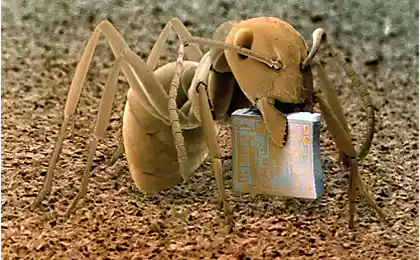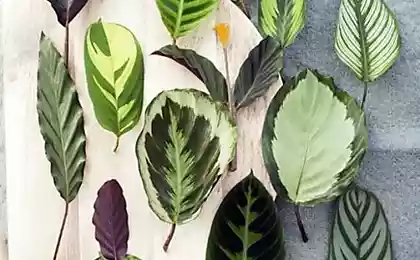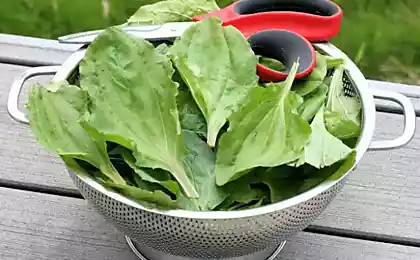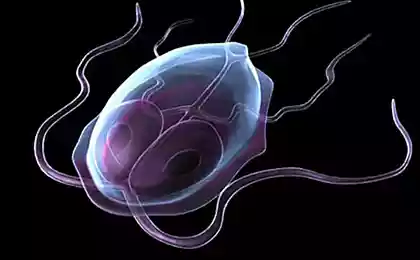440
New diagnostic technology
In recent times we have increasingly hear about microscopic diagnostic instruments used in medicine and in the field of environmental protection, capable of producing tests using very small amounts of natural fluids. However, working with such small amounts of analyte confronts the researcher with some problems, in particular difficulty with the correct mix of microscopic volumes of different liquids and control the individual drops used for analysis. A team of scientists at Washington University have found a solution to these problems by investigating the Lotus leaf.

As it turned out, the Lotus leaf has a unique microstructure. Its surface consists of microscopic cones topped with fine hairs. When a drop of liquid falls on the surface of the sheet, its weight is supported by the hairs, while under the drop remains a pocket of air. Suspended thus the drop is not deprived of mobility and as a result, even barely perceptible jolt or inclination of the surface is rolled with a sheet. In recent years this effect has been used in several technology – self-cleaning plastics, solar cells and even dust shields for spacecraft.
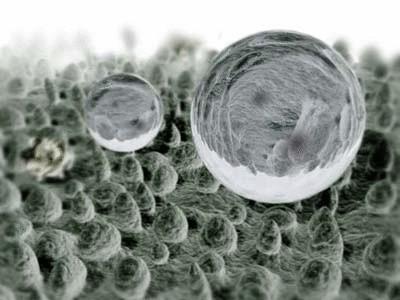
Researchers approximately replicated this structure using methods of nanotechnology, creating a silicone surface, consisting of tiny bars that differ in height and cross section. In the same way as in the natural prototype, drops placed on an artificial surface, taking almost perfect spherical shape.
Then, using speakers or other device, the surface is forced to vibrate with a frequency of from 50 to 80 vibrations per second. Experiments have shown, such vibration causes the drops to move along the trajectory defined by the parameters of the columns of silicon of the surface. Researchers were able to make droplets move on the most convoluted route up, down, around – and even to turn "upside down". In addition, it is possible to get two drops to merge together and then move as a single unit. "A change in the oscillation frequency allows researchers to control the speed of movement drops, and to determine the total mass of droplets of a certain size or weight.
Existing prototypes require relatively powerful source of vibration to produce the expected effect. However, in the nearest plans of the research group to create a thin surface with a mustache, a hundred times smaller than it is now, will successfully lead droplets in motion by the dynamics of the ordinary smartphone.
"All You need is the vibration source, the production of special surface is not absolutely no problem. It can be made out of a piece of plastic," — said the head of the research group, Karl Boehringer. – "I think the instrument to study samples of saliva, blood or any aqueous solution will ultimately cost less than one dollar. We assume that it will connect to an ordinary mobile phone and to receive energy from the phone battery. Special mobile application will generate the type of sound vibrations. And you can begin to study the samples!"
A photograph taken during the experiments, one can observe the blue and red drops of liquid moving through the upper and lower surfaces vibriruya platform at a speed of about one inch (2.54 cm) per second and merging at a meeting in the center.
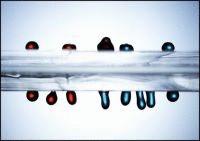
Source: /users/104

As it turned out, the Lotus leaf has a unique microstructure. Its surface consists of microscopic cones topped with fine hairs. When a drop of liquid falls on the surface of the sheet, its weight is supported by the hairs, while under the drop remains a pocket of air. Suspended thus the drop is not deprived of mobility and as a result, even barely perceptible jolt or inclination of the surface is rolled with a sheet. In recent years this effect has been used in several technology – self-cleaning plastics, solar cells and even dust shields for spacecraft.

Researchers approximately replicated this structure using methods of nanotechnology, creating a silicone surface, consisting of tiny bars that differ in height and cross section. In the same way as in the natural prototype, drops placed on an artificial surface, taking almost perfect spherical shape.
Then, using speakers or other device, the surface is forced to vibrate with a frequency of from 50 to 80 vibrations per second. Experiments have shown, such vibration causes the drops to move along the trajectory defined by the parameters of the columns of silicon of the surface. Researchers were able to make droplets move on the most convoluted route up, down, around – and even to turn "upside down". In addition, it is possible to get two drops to merge together and then move as a single unit. "A change in the oscillation frequency allows researchers to control the speed of movement drops, and to determine the total mass of droplets of a certain size or weight.
Existing prototypes require relatively powerful source of vibration to produce the expected effect. However, in the nearest plans of the research group to create a thin surface with a mustache, a hundred times smaller than it is now, will successfully lead droplets in motion by the dynamics of the ordinary smartphone.
"All You need is the vibration source, the production of special surface is not absolutely no problem. It can be made out of a piece of plastic," — said the head of the research group, Karl Boehringer. – "I think the instrument to study samples of saliva, blood or any aqueous solution will ultimately cost less than one dollar. We assume that it will connect to an ordinary mobile phone and to receive energy from the phone battery. Special mobile application will generate the type of sound vibrations. And you can begin to study the samples!"
A photograph taken during the experiments, one can observe the blue and red drops of liquid moving through the upper and lower surfaces vibriruya platform at a speed of about one inch (2.54 cm) per second and merging at a meeting in the center.

Source: /users/104

